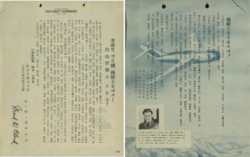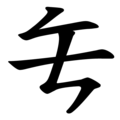Hanja
Hanja is the Korean word for Chinese characters. It is about the Chinese characters that are borrowed from the Chinese language and used in the Korean language with Korean pronunciation. Hanja-mal or hanja-eo is about words which can be written with hanja. Hanmun (한문) is about the Chinese Classical writing, but hanja can sometimes be used to generally mean hanmun too. Hanja was never very changed, so almost all of the Chinese characters in hanja are the same as in traditional Chinese. Only a few hanja characters are unique to Korea.
| Hanja | |
|---|---|
 | |
| Korean name | |
| Hangul | 한자/한문한자 |
| Hanja | 漢字/韓文漢字 |
| Revised Romanization | Hanja |
| McCune–Reischauer | Hancha |
In the 1440s, however, a Korean hangul alphabet relying on sound was made by a group of students, led by King Sejong the Great. It was not widely used at first. However, by the early 19th and 20th century it was more widely used than hanja, and it is now the official writing system of Korea.[1]
But until then, everyone mostly read and wrote in hanja, so most of the older books in Korean literature are written in hanja. Students who learn Korean history learn hanja to read historical papers. Children in South Korea still learn hanja, for many South Korean words still have roots in hanja. In North Korea, however, hanja has been abolished along with many Chinese loanwords, and North Koreans only use hangul to write in Korean.
Hanja Media
The calligraphy of Korean scholar, poet and painter Kim Chŏnghŭi (Hangul: 김정희; Hanja: 金正喜) of the early nineteenth century. Like most educated Koreans from the Three Kingdom period until the fall of the Joseon dynasty in 1910, Gim Jeong-hui composed most of his works in hanmun or literary Chinese.
Advertisements for hagwons (cram schools) in Seoul in 1971. Most of the text is in hanja, before the decline in its use.
A packet of Shin Ramyun. The Chinese character 辛, meaning 'spicy', is prominently displayed.
The Veritable Records of the Joseon Dynasty, an annual record of the Joseon dynasty throughout its entire history, was written in Classical Chinese.
This Korean War propaganda leaflet created by the US Army as part of Operation Moolah uses Hangul–Hanja mixed script.
Related pages
References
- ↑ Fischer, Stephen Roger (2004-04-04). A History of Writing. Globalities. London: Reaktion Books. pp. 189–194. ISBN 1861891016. Retrieved 2009-04-03.






